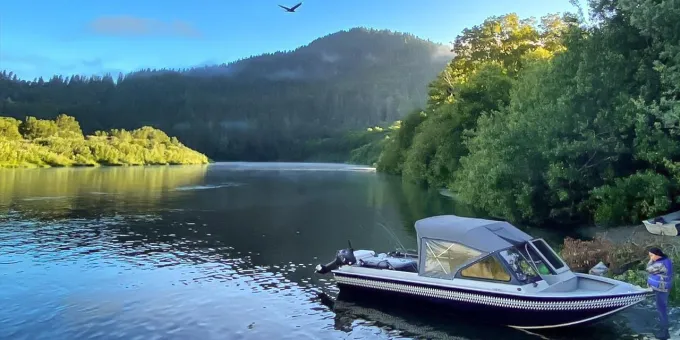Bounded by redwood-clad slopes, the Klamath River swirls and swerves through a 40-mile length of the Yurok Reservation. The fish swimming in this North Coast waterway lie at the heart of Yurok livelihood and culture.
“Fishing is a way of life,” says tribe member Pergish Carlson. “We eat food from the river, whether it’s salmon, eels, or sturgeon. The fish are involved in all of our ceremonies, rituals, and storytelling. We still have the same ceremonies we've always had, and salmon is always the main meal.”
A lifelong Klamath River fisherman, Carlson runs Blue Creek Guide Service. He takes anglers out on the river in his 24-foot jet boat to catch chinook salmon weighing as much as 20 pounds.
“Fishing on the Klamath is one of those experiences that people long remember,” Carlson says. “They do it once and they’re hooked. Part of the appeal is the landscape, which is a lot different than what most people know. Out on the river, you aren’t going to see roads or cars. It’s just the river and wildness. Most people think you have to go to Alaska to find wildness like this. They can’t believe how remote it is right here.”
Tribe member Morgan Clayburn, who operates his own guide service, says that a Klamath fishing trip delivers a lot more than dinner-table fare. “You have the chance to see bald eagles, osprey, black bears, otters, occasionally a black-tailed deer. We should start seeing condors soon because the tribe has reintroduced condors in the upper part of the river.”
The advantage of fishing with a Yurok guide, Clayburn says, is that you’ll gain a broad perspective on the river and the tribe’s history as its steward.
“I feel so fortunate that not only am I guiding on my aboriginal waters, my home waters, but I get to talk to people about our culture. I can point out ancient village sites and share the culture of this place. It’s nice to show people that it’s not just a fishing destination. This is where my people come from.”
On fishing trips, Clayburn tells his clients about his grandmother, who was the last person born in his tribe’s traditional village. “She used to row a boat across the Klamath River to catch the school bus. That was only two generations ago. We might be evolving as a people—we are running around in jet boats now—but the Klamath is still a very wild place.”
Both Yurok guides were born and raised on the river. “We’re fishing people,” Clayburn says. “From the time I was little, I grew up with my mom gill-netting on the river. I was always at the river, so to me the river feels like home.”
Today Clayburn and Carlson fish mostly with rods and reels, and Carlson is teaching his four children the craft. “They’ve all caught salmon, even my four-year-old. My 11-year-old has caught multiple big fish,” he says.
In addition to its salmon runs, the Klamath River also boasts a world-class steelhead fishery that appeals to catch-and-release anglers. “A lot of hardcore anglers like the steelhead because they're a really good fight. They're very acrobatic; they jump out of the water. They provide that thrill,” Clayburn says.
Steelhead are present in the river much of the year, but the busiest fishing season is August and September when the chinook salmon swim upriver to their original spawning grounds.
“On the Klamath, salmon is the fish that everyone’s chasing after. Everybody wants to eat salmon,” Carlson says. “It’s not just sport fishermen. Everyone in the tribe is trying to switch their diets from American beef and pork to salmon, acorns, and all the river food. It’s so much healthier to eat.”
Carlson’s freezer is filled with elk, deer meat, salmon, and steelhead. “All of our food is based on what we catch. Every night we try to incorporate one of those for our meat,” he says.
Carlson’s six-year-old daughter loves to eat Klamath River eels, he says. Outside of the tribe, they aren’t popular table fare, but in his family, they’re a staple. Carlson prepares them the traditional ways by grilling, smoking, and canning them.
“Eels are a super food. One eel has as much omega-3 as three salmon. In the old days, our people might have had to walk 20 or 30 miles in one day. They could eat one of those eels and it would give them enough protein to do that.”
Clayburn says the Klamath River provides him with food and a livelihood, as well as something more intangible. “When it's 5:30 and you're running up the river in the pitch-black darkness to your first spot, and then the sun comes out, you think, ‘This is my job? This is my office?’ I'm very fortunate to do what I do and live where I live.”
